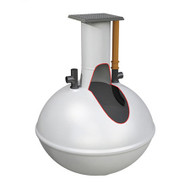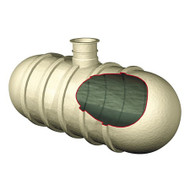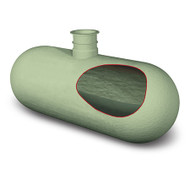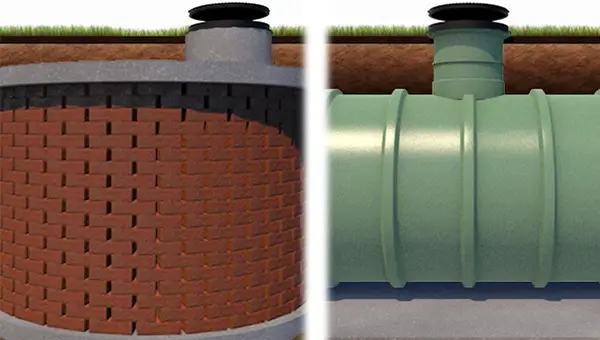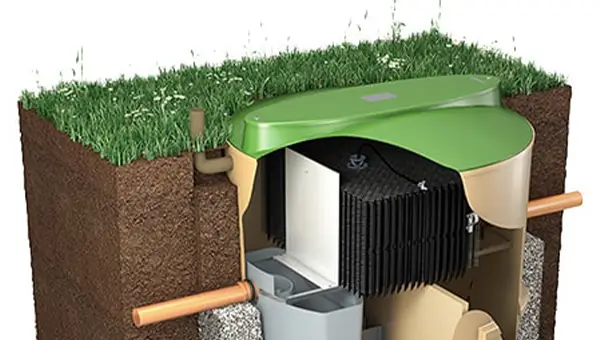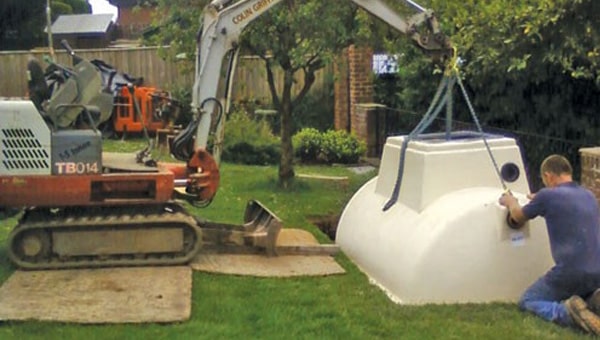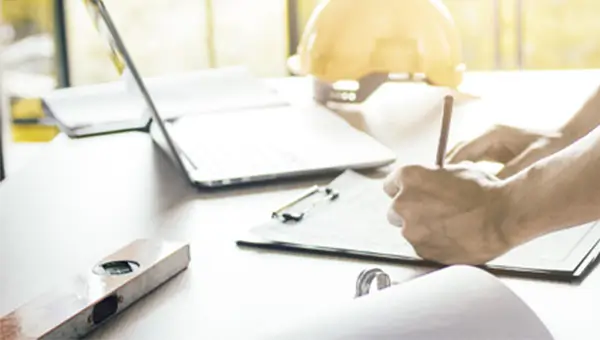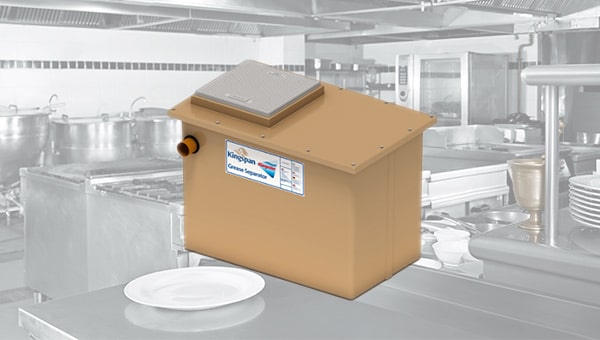If you’ve searched online for cesspools or silage tanks, you’ll no doubt have noticed that they often look exactly the same. This is because, essentially, the tanks themselves are the same in design and built for both uses; at least externally. Internally, however, there is a significant difference depending on what is to be stored within.
What are Cesspools?
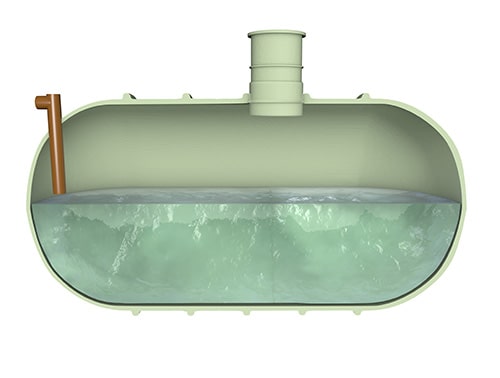
Cesspools are single chambered, sealed tanks that collect and temporarily store wastewater and sewage from households and businesses that are not connected to a mains sewer. Usually installed underground, these tanks do not process or treat the waste in anyway, nor do they release effluent in to the environment as a septic tank does. For this reason, they are effectively just holding tanks that must be emptied regularly by a registered waste carrier.
Depending on the size of the tank and the number of occupants within the property, a cesspool may need to be emptied annually, quarterly, monthly or even weekly. This can obviously become quite costly and, as such, cesspools are becoming less and less common in the UK. More popular/economical options are septic tanks or sewage treatment plants. However, as a last resort, in locations where it might be impractical/impossible to use any other option (such as campsites/caravan parks), cesspools can still provide a reliable solution for the collection and storage of effluent.
If a cesspool is your only option, then a general rule of thumb when deciding which size to go for is… bigger is always better! The larger the tank, the longer you can go before it needs emptying. For domestic applications (i.e. houses), Building Regulations state a requirement of at least an 18,000 litre capacity for 2 users, giving up to 45 days holding, and then an extra 6,800 litres per additional user. So, for example, a 45,200 litre tank for a four bed house (calculated for 6 persons) would require emptying every 40-45 days (based on a 180 litres per person, per day production of wastewater).
Smaller cesspools are available for non-domestic applications, such as small offices on industrial sites and small campsites/caravan parks (unless Blue Loo is used, in which case you would require a silage tank). However, it is still always worth overestimating the required capacity (within reason of course) for both peace of mind against overfills and to minimise the annual cost of having it emptied. It is also highly recommended that you choose a tank with a high level alarm (or fit an alarm retrospectively to an existing tank), regardless of the tank size you choose.
Rules & Regulations for Cesspools
First rule of cesspool club: cesspools are illegal in Scotland. You should consider a septic tank or sewage treatment plant instead.
If you already have a cesspool on your property you do not need to register it, apply for a permit, or make sure if complies with General Binding rules.
If you plan on installing a new cesspool, you must:
- Comply with Building Regulations; be sure you have the space to install it — a minimum of 7 metres from a building and 2 metres from a boundary is required.
- Get planning permission from your local authority.
- For domestic installations: make sure it has a minimum capacity of 18,000 litres for 2 persons (plus another 6,800 litres per additional persons).
- For non-domestic installations: make sure it has a capacity for at least the minimum requirements for the application.
If you have a cesspool:
- Check the level in the tank regularly as it is an offence under the 1936 Public Health Act to let it overfill. It's important to do this with a high level alarm and not by opening the manhole cover; cesspools will contain toxic fumes that can be harmful to you.
- Make sure it is suitably maintained and checked regularly for damage or leaks.
- Arrange for it to be emptied regularly by a registered waste carrier; this is your responsibility, so make sure you receive proper paperwork to prove the carrier is disposing of the waste at a specialised waste disposal site.
- Keep the manhole area clear for easy access.
- Use biologically-friendly household cleaning products to avoid hazardous/flammable liquids getting into the tank.
The Environment Agency/local authority can force you to repair or replace your cesspool if it’s in poor condition and can issue large fines if it is found to be in violation of the law. If you are considering installing a cesspool, and want to make sure it will be fully compliant with all regulations, we highly recommend speaking to a member of our technical team for free, no-obligation advice.
What are Silage Tanks?
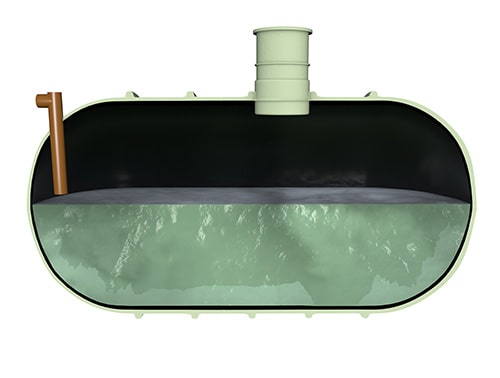
Silage Tanks are also single chambered, sealed tanks that collect and temporarily store effluent. However, where cesspools are designed for household and business waste water and sewage, silage tanks are designed for agricultural waste.
According to advice given by the Scottish Government silage effluent has a biochemical oxygen demand (BOD) of up to 200 times that of raw sewage. This would mean that 500 tonnes of unwilted silage has the same polluting potential as the daily untreated sewage from a town/city of about 200,000 people! Because of this toxicity, and amount of silage effluent produced by farms in the UK per year, the potential for pollution is extremely high. If silage effluent is allowed to enter a watercourse, it rapidly strips oxygen from the water killing fish, plants and other aquatic life; it's therefore imperative that this waste is collected, stored and disposed of properly.
Internal protective layer
Silage tanks are manufactured with an internal protective liner to shield them from attack by silage effluent (usually with either bituminous paint, butyl rubber, glass fibre, proprietary resin or another equivalent material). This is the important difference between silage tanks and cesspools. Without this liner, silage effluent cannot be safely stored in such a tank.
Minimum capacities of silage tanks
Regulations state that effluent tanks must have a minimum capacity of no less than 3m3 for each 150m3 (or part thereof) of silo capacity for a silo of less than 1500m3 capacity. For larger silos, the effluent tank is required to have a capacity of at least 30m3 plus 1m3 for each 150m3 (or part thereof) of silo capacity in excess of 1500m3.
These capacities are a minimum and are unlikely to be sufficient for two days' storage for unwilted silage or silage made in an unroofed silo, and it is important to plan accordingly. It's also important to remember that effluent can be produced from other livestock feeds, such as draff and whole crop cereals, which must also be collected and not allowed to escape and cause pollution. It’s up to you to ensure you’ve enough capacity to avoid all risk of pollution. Like with a cesspool, bigger is probably going to be better when choosing your tank size.
Rules & Regulations for Silage Tanks
For the installation of new silage tanks:
- Notify the Environment Agency (England) or NRW (Wales) at least 14 days before you intend to install a silage tank. For SEPA (Scotland) or DAERA (Northern Ireland) the required notification period is 28 days prior to install.
- Follow the specific rules for the substance you are storing.
- If installed above ground, ensure the tank has a minimum expected lifespan of 20 years with maintenance.
- If installed below ground, or partly below ground, ensure the tank has a minimum expected lifespan of 20 years without maintenance.
- The tank must be sited at least 10 metres clear of inland or coastal waters. A larger safety zone may be needed near certain areas under instruction by the national or local authority.
- Check and empty the tank as often as is necessary depending on your own circumstances and experience.
Can you store silage effluent and slurry together?
Technically, yes, you can store silage effluent and slurry together as long as your tank has enough capacity and the tank is built to withstand both types of effluent. However, mixing slurry can give off gases that are lethal to humans and livestock, and you must never put silage effluent into an under-floor slurry store. If you have any other questions regarding the storage of agricultural waste, or need help choosing the correct tank for you, contact our technical team for free, professional advice.
Do I need a cesspool or silage tank?
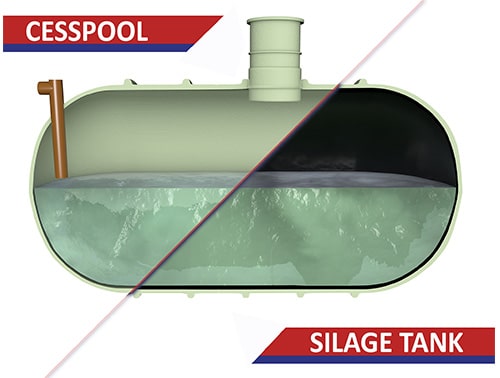
What is the difference between a cesspool and a silage tank? Ultimately, it’s that cesspools are designed for the storage of household and business waste, while silage tanks are designed for the storage of more harmful agricultural waste.
While the tanks do often look the same, and both store waste that must be regularly emptied to prevent harmful overspills, the additional liner required to contain silage effluent creates an essential difference. Whilst a cesspool may appear to be a cheaper option than the equivalent size silage tank, the lack of the protective liner makes a cesspool extremely unsuitable for silage effluent. Without the protective liner, a cesspool would not be able to safely contain this highly toxic and acidic waste, greatly increasing the risk of polluting the environment, which would then land you with a substantial fine AND leave you needing to replace it with the more expensive silage tank you should have bought in the first place. That initial saving really is not worth the risk.
JDP has a wide range of both cesspools and silage tanks available, and our team is always ready to answer any of your questions and offer advice if you need help choosing the right one for your project.
Alternatively, for domestic sewage needs, consider checking out our range of septic tanks or sewage treatment plants for a more economical solution, or contact us today to discuss any of your sewage treatment needs!

